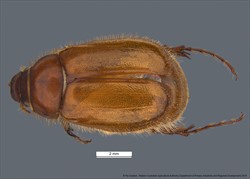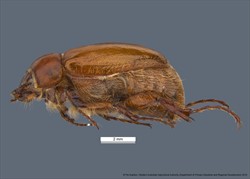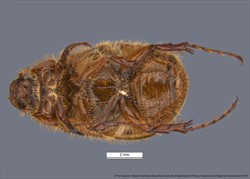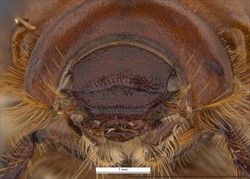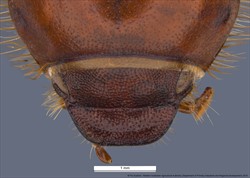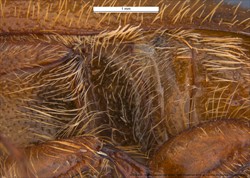Sub family: Melolonthinae / Tribe: Liparetini / Genus: Liparetrus
Fact Sheet
Liparetrus Guérin-Méneville, 1831
Small shiny beetles, 3-14mm in length. Body colouration black, reddish, yellowish or brown, not metallic. Elytra shortened, leaving propygidium mostly exposed. Clypeus with a varyingly shaped apex- crenulate, sinuate, truncate, curved/rounded, or emarginate forms have all been recorded. Labrum located below clypeus, and separated by a suture. Antennae usually 9-segmented, rarely 7-8 segmented. Antennal club always 3-segmented. Metacoxae usually with pale transparent margins. Propygidium often fused with penultimate ventrite into a continuous ring around the pygidium. Foretibia usually bidentate. If tridentate, then the third tooth is not close to base of tibia. Tarsal claws simple.
Liparetrus are usually found feeding on flowers or foliage of various species of Eucalyptus. Adult emergence can be brought about by rain.
Larvae are soil dwellers, feeding on organic matter.
Liparetrus are found only in Australia, and can be found across all Australian states and territories. The majority of species can be encountered through inland environments. Nearly half of all species are known from Western Australia.
(PDF) Britton (1980) A revision of the Australian chafers (Coleoptera: Scarabaeidae: Melolonthinae), 3. Tribe Liparetrini: genus Liparetrus: http://www.publish.csiro.au/zs/pdf/ajzs076
Britton, E.B. 1980. A revision of the Australian chafers (Coleoptera: Scarabaeidae: Melolonthinae), 3. Tribe Liparetrini: Genus Liparetrus. Australian Journal of Zoology, Supplementary Series 76, 1–209.
Britton, E.B. 1990. A Synopsis of the Australian genera of Liparetrini (Coleoptera: Scarabaeidae: Melolonthinae). Invertebrate Systematics, 4 (1), 159-195.
Weir T.A., Lawrence J.F., Lemann C., Gunter N.L. 2019. 31. Scarabaeidae: Melolonthinae Leach, 1819. In: Australian Beetles. Volume 2. Archostemata, Myxophaga, Adephaga, Polyphaga (part) (eds A Ślipiński & JF Lawrence) pp. 516–530. CSIRO, Clayton, Australia.

